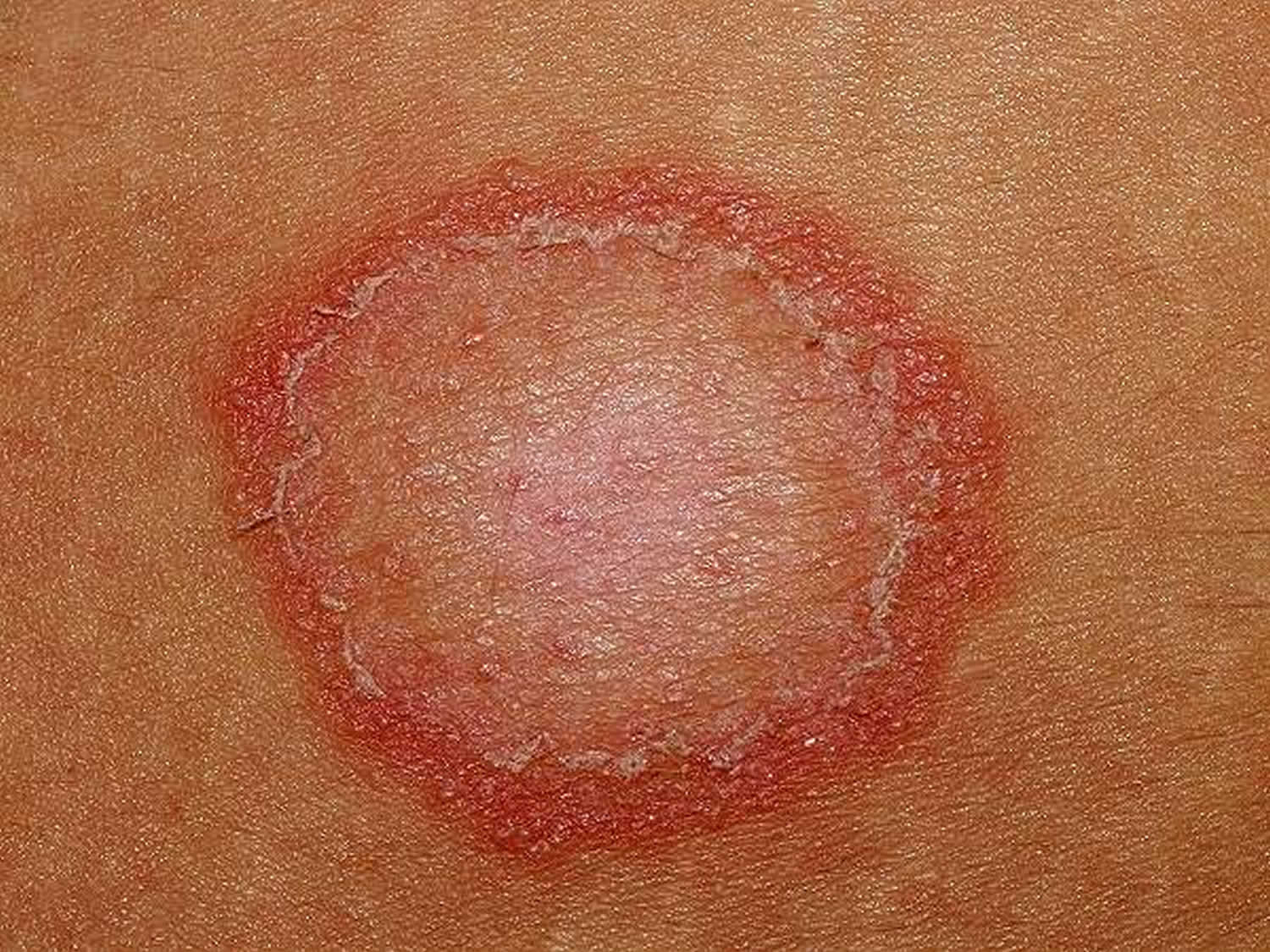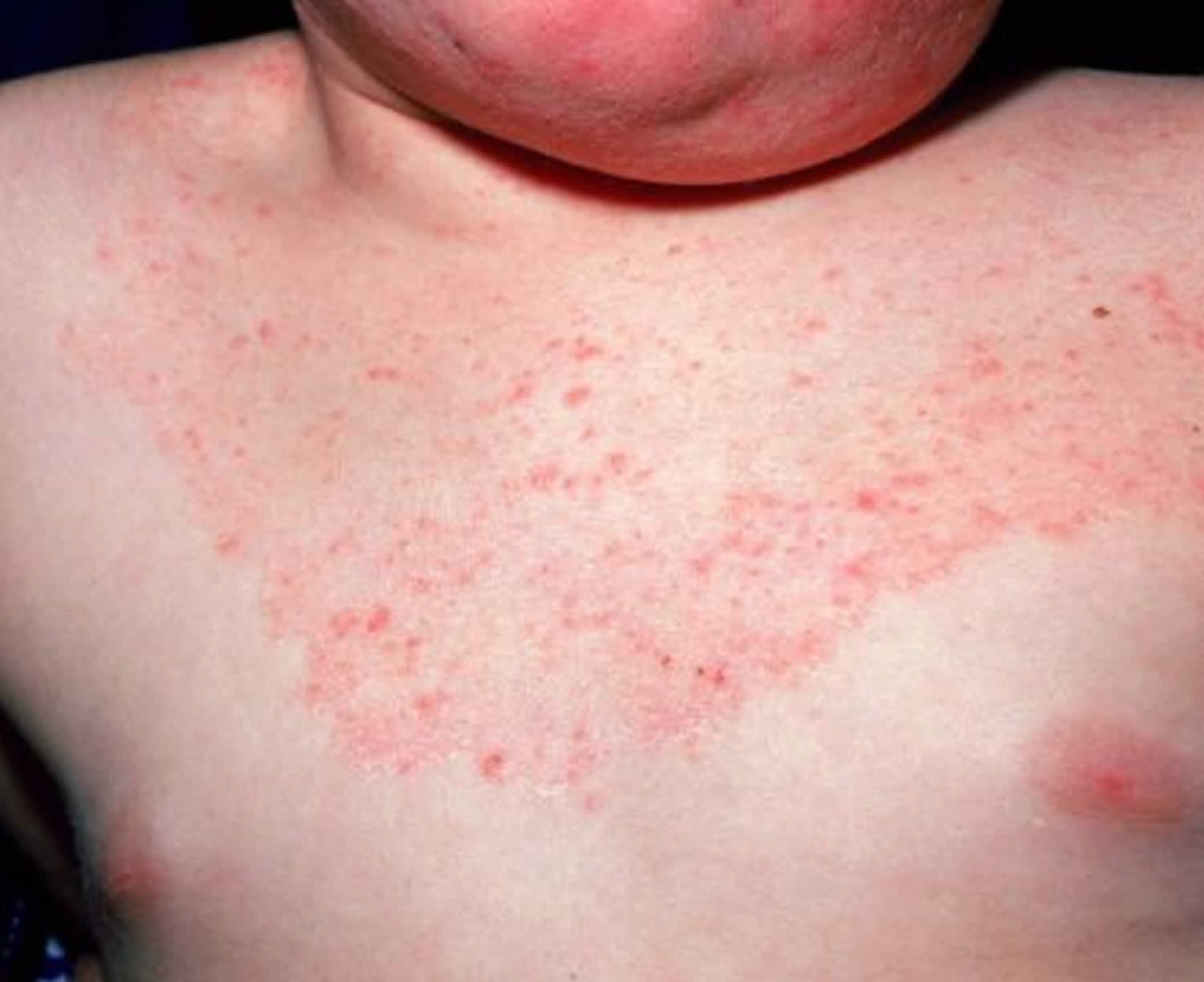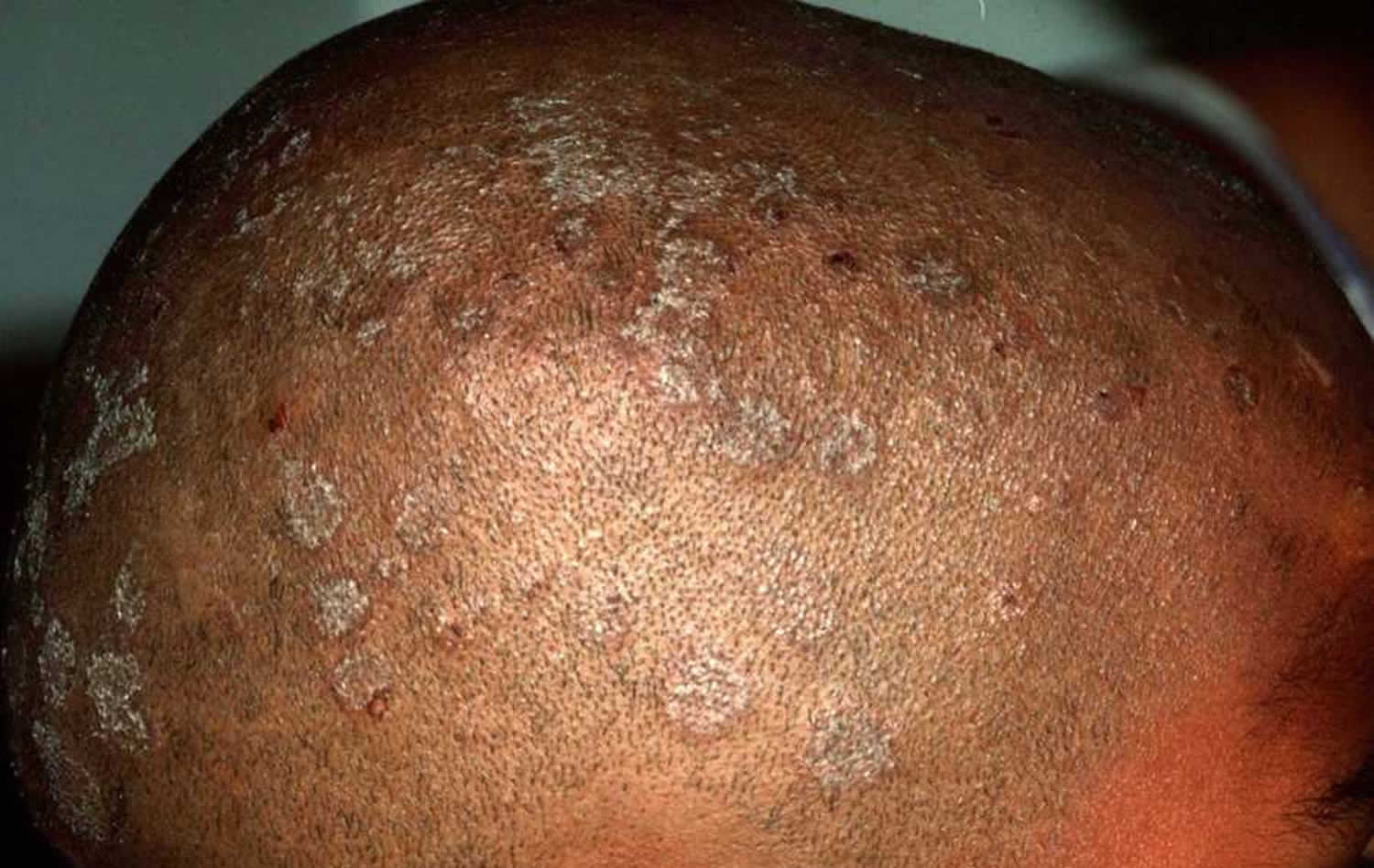Ringworm in babies
Ringworm also known as tinea corporis, is tinea infection of the surface (superficial) skin with a dermatophyte fungus or ringworm fungus. Ringworm may be passed to humans by direct contact with infected people, infected animals (such as kittens or puppies), contaminated objects (such as towels or locker room floors), or the soil. Tinea infection is commonly called ringworm because some may form a ring-like pattern on affected areas of the body and spreads outward. The rash is not caused by a worm, it is caused by a dermatophyte fungus that likes moist areas, but can also live on surfaces and household items and spread by communal use of hats or hairbrushes. The fungus infects the skin, but they don’t spread inside the body.
Depending on which part of the body is affected, tinea infection is given a specific name:
- Tinea barbae (beard)
- Tinea capitis (head)
- Tinea corporis (body)
- Tinea cruris (groin)
- Tinea faciei (face)
- Tinea manuum (hand)
- Tinea pedis (foot)
- Tinea unguium (nail)
Sometimes, the name gives a different meaning:
- Tinea versicolor is more accurately called pityriasis versicolor. This is a common yeast infection on the trunk.
- Tinea incognita (often spelled incognito) refers to a tinea infection in which the clinical appearance has changed because of inappropriate treatment.
- Tinea nigra is a mold infection (not a dermatophyte). It affects the palms or soles, which appear brown (on white skin) or black (on dark skin).
There are several kinds of ringworm, including:
- Majocchi’s granuloma, a deeper fungal infection of skin, hair, and hair follicles. It is most common in women who shave their legs.
- Tinea corporis gladiatorum, a special name given to ringworm spread by skin-to-skin contact between wrestlers.
- Tinea imbricata, a form of ringworm seen in Central and South America, Asia, and the South Pacific.
Children most commonly get ringworm from young animals, like kittens and guinea pigs. They can also pick it up through contact with infected people and contaminated objects, including carpet, floors, clothing and towels. Soil contains ringworm fungi too. The fungus can also be spread during contact sports, like wrestling.
Ringworm can affect any skin on the body. It’s called different things depending on where it is on the body. For example, on the torso it’s called tinea corporis, on the feet it’s called tinea pedis, and on the scalp it’s called tinea capitis. Ringworm can also lead to nail infections.
Ringworm initially appears on the skin as a red ring with a clear center, scales and a lumpy or raised edge. It’s very itchy and can gradually get bigger. It sometimes spreads to other areas.
If your child’s scalp is affected, you might notice a small bald patch with some hair stubble.
Ringworm is treated using antifungal lotions or pills and the infection typically heals in about a month. Ringworm (tinea corporis) is usually treated with topical antifungal creams which you can buy over the counter at the pharmacy, but if the treatment is unsuccessful, oral antifungal medicines may be considered, including terbinafine and itraconazole.
Ringworm treatment with antifungal creams usually takes several weeks to work. Your doctor might recommend that you keep applying the cream to the affected skin for a week after the rash has disappeared. This should stop the ringworm coming back.
If antifungal creams don’t work, or the ringworm is on your child’s scalp, your doctor might prescribe antifungal tablets. These need to be taken under medical supervision. If the infection is on the scalp, your child might have bald patches for a few months after it has cleared. Don’t worry, though – the hair will grow back normally.
Encourage your child to stop scratching the affected area.
After your child starts proper ringworm treatment, wait for 48 hours before sending him back to child care, preschool or school.
It’s a good idea to treat all family members affected by ringworm.
Consult your vet for treatment if your pet has bald patches or sores, because this might be where your child has picked up the ringworm.
Ringworm key points to remember:
- Ringworm (tinea) is a fungal infection that is highly contagious and affects the scalp, body, feet or nails.
- Ringworm is spread by contact with a person or animal who has ringworm, or by touching an object or surface that may contain the fungus (e.g. brushes, showers or towels).
- Antifungal medications are used to treat ringworm – early treatment is important.
Figure 1. Ringworm rash baby
Figure 2. Tinea capitis (scalp ringworm)
You should take your child to the doctor if:
- there are several ringworm sores on your child’s scalp or body
- the sores are painful
- the rash doesn’t start to improve after a week’s treatment
- the rash is spreading despite treatment
- there are bald patches in your child’s hair.
What causes ringworm?
Ringworm or tinea corporis is the name used for infection of the trunk, legs or arms with a dermatophyte fungus. Ringworm is a localized inflammatory skin condition due to fungal colonization of the superficial epidermis. The most commonly implicated species is Trichophyton rubrum (T. rubrum). Infection often comes from the feet (tinea pedis) or nails (tinea unguium) originally. Microsporum canis (M. canis) from cats and dogs, and Trichophyton verrucosum, from farm cattle, are also common. Fungal organisms are transmitted to children by direct contact with those infected or through fomites. Varying location presentations include tinea capitis (scalp), tinea faciei (face), tinea pedis (feet), tinea manuum (hands), and tinea cruris (crural folds).
Majocchi granuloma is caused by organisms invading the hair follicle or shaft of hairs on skin other than the scalp with a secondary granulomatous perifolliculitis.
Disseminated tinea may be seen in patients with immunosuppression, diabetes, Cushing syndrome, and malignancy. Majocchi-like granulomas, deep ulcerated fungal infections, severe tinea capitis and corporis, and fungal nail involvement are characteristic of an inherited deficiency of CARD9 (caspase recruitment domain-containing protein 9), an inflammatory cascade-associated protein. The disorder is autosomal recessive and is most common in North African countries including Algeria, Morocco, and Tunisia. The infections usually begin in childhood and are caused by Trichophyton rubrum and Trichophyton violaceum. Lymphadenopathy, high IgE antibody levels, and eosinophilia are common, and the disorder can be fatal.
Tinea imbricata is a distinct form of tinea corporis caused by Trichophyton concentricum, which is prevalent in tropical locales such as Central and South America, the South Pacific, and Southeast Asia. This form has been reported in children as well.
Tinea indecisiva (tinea pseudoimbricata) is tinea corporis that mimics tinea imbricata. These cases are not caused by Trichophyton concentricum but rather by other Trichophyton or Microsporum species. There is usually underlying immunosuppression in patients with tinea indecisiva.
Tinea capitis
Tinea capitis is the name used for infection of the scalp with a dermatophyte fungus. Although common in children, tinea capitis is less frequently seen in adults.
Hair can be infected with Trichophyton and Microsporum fungi.
Microsporum canis is the usual dermatophyte fungus to cause tinea capitis. This fungus is zoophilic and grows naturally on an animal rather than a human. Microsporum canis tinea capitis is due to contact with an infected kitten or rarely an older cat or dog.
Other zoophilic fungi sometimes found to cause tinea capitis are:
- Trichophyton verrucosum (originating from cattle)
- Trichophyton mentagrophytes var. equinum (originating from horses)
- Microsporum nanum (originating from pigs)
- Microsporum distortum (a variant of Microsporum canis found in cats).
In the United States, Trichophyton tonsurans has also become a common cause of tinea capitis; this is passed on from one person to another as it naturally infects humans (i.e. it is anthropophilic). It frequently causes no symptoms and is commonly found in adult carriers.
Other anthropophilic fungi sometimes found to cause tinea capitis are:
- Trichophyton violaceum especially in African patients
- Microsporum audouinii
- Microsporum ferrugineum
- Trichophyton schoenleinii
- Trichophyton rubrum
- Trichophyton megninii
- Trichophyton soudanense
- Trichophyton yaoundei.
Dermatophyte fungi sometimes originate in the soil (geophilic organisms). These rarely cause tinea capitis:
- Nannizzia gypsea
- Microsporum fulvum.
How is ringworm in babies spread?
Ringworm infections are transmitted by contact with an infected person or animal or by contact with personal items or surfaces used by infected people, such as clothes or hairbrushes.
How to prevent ringworm infections?
Ringworm is spread by contact with infected humans, animals and contaminated objects and surfaces. Children are most likely to be infected by other people who already have ringworm, via school playgrounds, gyms, contaminated clothing, bath mats, towels, damp floors and showers.
Preventing others from coming into contact with the wound or from sharing personal use items helps to prevent transmission to others. Keeping feet covered in areas such as gyms, pools and locker rooms is also of value.
Because ringworm is very contagious, it can be difficult to prevent. However, there are ways you can help your child avoid being infected:
- Avoid contact with infected people. Where this is not possible, wash hands thoroughly after contact, and dry them well.
- Pets with bald spots may have ringworm, so care should be taken to avoid touching or petting them. Have any household pets evaluated by a veterinarian to make sure that they do not have a tinea infection. If the veterinarian discovers an infection, be sure to have the animal treated.
- Avoid contact with infected pets, and wash your pets with anti-fungal solution.
- Clothing and sheets used by infected people should be washed daily.
- Pay special attention to drying moist areas on the body (e.g. armpits, groin, in between toes).
- Don’t share brushes, combs, hats, clothing, linen or towels with an infected person.
- Don’t walk in bare feet on damp floors or in communal showers.
If your child has ringworm:
- Cover the rash with clothing or a dressing (e.g. a Band-Aid).
- Don’t let them use communal pools or baths until you have started the appropriate treatment.
- Wash their clothing, towels and bed linen often and with hot water.
- Spray their shoes with anti-fungal spray if the ringworm is on their feet. This will help stop their feet being reinfected after treatment.
Who’s at risk of ringworm?
Ringworm may occur in people of all ages, of all races, and of both sexes.
Ringworm is most commonly seen in children. Other people who are more likely to develop ringworm include:
- Women of child-bearing age who come into contact with infected children.
- People who have another tinea infection elsewhere on their bodies: tinea capitis (scalp), tinea faciei (face), tinea barbae (beard area), tinea cruris (groin), tinea pedis (feet), or tinea unguium (fingernails or toenails).
- Athletes, especially those involved in contact sports.
- People in frequent contact with animals, especially cats, dogs, horses, and cattle.
- People with weakened immune systems.
- People who sweat heavily.
- People who live in warmer, more humid climates.
Ringworm signs and symptoms
Rashes caused by ringworm can occur on almost any part of the body and often take the shape of a ring that is red on the outside and skin-colored in the middle. Ringworm rash appears as one or more red, scaly patches ranging in size from 1–10 cm. The border of the affected skin may be raised and may contain bumps, blisters, or scabs. Often, the central portion of the lesion is clear, leading to a ring-like shape and the descriptive name ringworm (a misnomer since the condition is not caused by a worm).
Ringworm may cause itching or burning, especially in people with weak immune systems.
The most common locations for ringworm include:
- Neck
- Trunk (chest, abdomen, back)
- Arms
- Legs
If the ringworm occurs on a part of the body that has hair, such as the scalp or on a bearded face, the hair may fall out. If nails are infected, they may become thick and discolored.
Infected areas may rarely become warm, red and tender if an abscess or cellulitis occurs. Bacterial infections may complicate the infection if it is scratched open and the bacteria, such as those that cause impetigo, can enter the wound.
Tinea capitis signs and symptoms
Tinea capitis is most prevalent between three and seven years of age. It is slightly more common in boys than girls. Infection by Trichophyton tonsurans may occur in adults.
Anthropophilic infections such as Trichophyton tonsurans are more common in crowded living conditions. The fungus can contaminate hairbrushes, clothing, towels and the backs of seats. The spores are long-lived and can infect another individual months’ later.
Zoophilic infections are due to direct contact with an infected animal and are not generally passed from one person to another.
Geophilic infections usually arise when working in infected soil but are sometimes transferred from an infected animal.
Tinea capitis may present in several ways:
- Dry scaling — like dandruff but usually with moth-eaten hair loss
- Black dots — the hairs are broken off at the scalp surface, which is scaly
- Smooth areas of hair loss
- Kerion — a very inflamed mass, like an abscess
- Favus — yellow crusts and matted hair
- Carrier state — no symptoms and only mild scaling (Trichophyton tonsurans).
Tinea capitis may result in swollen lymph glands at the sides of the back of the neck. Untreated kerion and favus may result in permanent scarring and bald areas.
It can also result in an id reaction, especially just after starting antifungal treatment.
Ringworm diagnosis
Your doctor might use a special light to help diagnose ringworm, or send some skin scrapings from the area to a laboratory for examination. The diagnosis of ringworm (tinea corporis) is confirmed by microscopy and culture of skin scrapings. Occasionally, the diagnosis is made on skin biopsy because of characteristic histopathological features of tinea corporis and organisms may be found in the outside layers of the skin.
Tinea capitis diagnosis
Tinea capitis is suspected if there is a combination of scale and bald patches. Wood light fluorescence is helpful but not diagnostic as it is only positive if the responsible organism fluoresces, and fluorescence is sometimes seen for other reasons.
The diagnosis of tinea capitis should be confirmed by microscopy and culture of skin scrapings and hair pulled out by the roots (see laboratory tests).
Sometimes, diagnosis is made on skin biopsy showing characteristic histopathological features of tinea capitis.
Ringworm treatment for babies
If you suspect that your child has ringworm, you might try one of the following over-the-counter antifungal creams or lotions:
- Terbinafine
- Clotrimazole
- Miconazole
Apply the cream to each lesion and to the normal-appearing skin 2 cm beyond the border of the affected skin for at least 2 weeks until the areas are completely clear of lesions. Because ringworm is very contagious, have your child avoid contact sports until lesions have been treated for a minimum of 48 hours. Do not allow your child to share towels, hats, or clothing with others until the lesions are healed.
Since people often have tinea infections on more than one body part, examine your child for other ringworm infections, such as on the face (tinea faciei), in the groin (tinea cruris, jock itch), or on the feet (tinea pedis, athlete’s foot).
When to seek medical care
- If large areas of the body are affected, or if the lesions do not improve after 1–2 weeks of applying over-the-counter antifungal creams, see your child’s doctor for an evaluation.
Treatments your doctor may prescribe
In order to confirm the diagnosis of ringworm, your child’s physician might scrape some surface skin material (scales) onto a slide and examine them under a microscope. This procedure, called a potassium hydroxide (KOH) preparation, allows the doctor to look for tell-tale signs of fungal infection.
Once the diagnosis of ringworm has been confirmed, the physician will probably start treatment with an antifungal medication. Most infections can be treated with topical creams and lotions, including:
- Terbinafine
- Clotrimazole
- Miconazole
- Econazole
- Oxiconazole
- Ciclopirox
- Ketoconazole
- Sulconazole
- Naftifine
- Butenafine
Rarely, more extensive infections or those not improving with topical antifungal medications may require 3–4 weeks of treatment with oral antifungal pills or syrups, including:
- Griseofulvin
- Terbinafine
The ringworm should go away within 4–6 weeks after using effective treatment.
Tinea capitis treatment
Tinea capitis is usually treated oral antifungal medicines, including griseofulvin, terbinafine and itraconazole.
Oral antifungal agents
Tinea capitis requires treatment with an oral antifungal agent. Griseofulvin is probably the most effective agent for infection with Microsporum canis. Scalp Trichophyton infections may successfully be eradicated using oral terbinafine, itraconazole or fluconazole for 4 to 6 weeks. However, these medications are not always successful, and it may be necessary to try another agent. Intermittent treatment may also be prescribed such as once-weekly dosages.
Treatment of carriers
If the child has an anthropophilic infection, all family members should be examined for signs of infection. Brushings of scaly areas of the scalp should be taken for mycology. Sometimes it is best for the whole family to be treated whether or not the fungal infection is proven.
It is advisable for parents of classmates and other playmates to be informed so their children may be examined and treated if necessary. In some countries, infected children are not allowed to attend school. Elsewhere children with tinea capitis can attend school providing they are receiving treatment.
Carriers may have no symptoms. Treatment of carriers is necessary to prevent the spread of infection. Antifungal shampoo twice weekly for four weeks may be sufficient, but if cultures remain positive, oral treatment is recommended.
Suitable shampoos include these ingredients:
- 2.5% selenium sulfide
- 1% to 2% zinc pyrithione
- Povidone-iodine
- 2% Ketoconazole.







